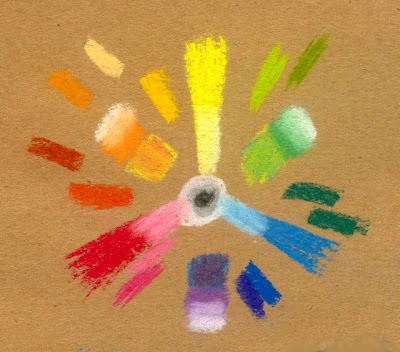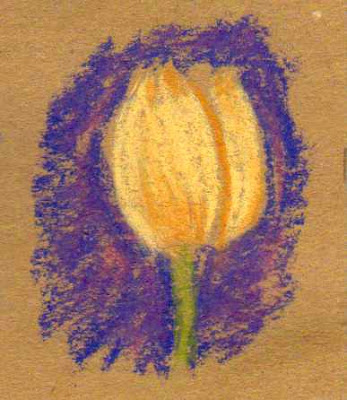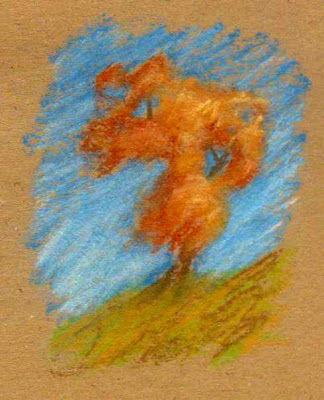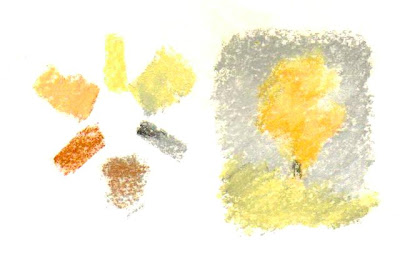
Art journals, especially on watercolor or multi-media paper, serve a greater purpose than just chronicling your life and creating an artwork that's a compilation. They do that too. They are to painting what sketchbooks are to drawing. With wet media, they're also useful as a concrete record of what your exact supplies do.
When you set out to do a serious painting, you'll be able to flip through your old watercolor journals or multimedia journals and decide whether you want to use acrylics thinned down till they behave like watercolor, opaque watercolor aka gouache, transparent watercolors, watercolor pencils. Anything you've ever tried, you can get a good idea how it's going to behave in your art journal.
Beyond that, devote some pages to charting any new paints you get. My examples are in watercolor. I tend to purchase a lot of different watercolors. Daniel Smith is always tempting me with new triads, then I see something else on sale, a friend gives me a present, funny how it mounts up. It doesn't help that I came to painting out of doing pastels and colored pencils when it really does matter to have a green exactly one step yellower and one step lighter and one step duller than the last one. Or three different greens that go in each of those directions.
With paint, you have a lot more freedom for what to work with. You can even start with three tubes of good artist grade watercolor and get a great result just with that. Wow! Hey! Watercolor's the way to go then, right? Lots cheaper! You don't even need white if you're using white paper and being purist about it.
If you do this, the colors to start with are Permanent Rose (or some other magenta sort of purplish bright red), Lemon Yellow and Ultramarine Blue. You definitely want Ultramarine Blue because that is the workhorse pigment. Ultramarine Blue mysteriously gets used up fastest out of all the watercolors I've ever bought. In pan sets, that's always the little half-pan that empties out first and gets refilled most often.
Those exact three colors by name from Winsor & Newton will give you a good three-color starting set. Add Winsor Yellow (or Hansa Yellow Medium if it's Daniel Smith), Scarlet Lake and Pthalo Blue Green Shade and you have a wonderful Split Primary Palette that will let you mix all the bright colors there are as well as any grays or browns. These are the exact colors listed by Winsor & Newton in their very useful guides to paints and pigments on
http://www.winsornewton.com, a site that has an enormous amount of information on painting.
But whether you go there or get the Daniel Smith Primary Triad or a Holbein starter set or any other brand, the first thing to do with your new watercolors is to chart them. Just like the image below.

Actually, since you haven't been collecting watercolors for years and testing them routinely, chart them a little more thoroughly than that. These are working charts, just the brand and color name. I'm familiar with all of these pigments since that little eight color set is something I threw together recently in my art journal. It's a reminder of the specific colors I chose to put into a little 8 color pocket set that I pried out the children's paint from to have something that fits on a keychain.

I've got my Split Primaries, Sodalite Genuine because it's a mineral pigment about the color of Payne's Grey that I like for both monochrome sketching and as a cool darkener, and Quinacridone Gold, which is just useful. I could have substituted it for the Indian Yellow since it is a warm (orange cast) yellow when it's thin. But I decided I wanted the Indian Yellow in too. It gives me a bit more variety in mixtures to have three yellows, that's a personal choice based on the pigment qualities.
A thorough, first-time beginner's color chart should be sorted out with a lot more written detail. It helps to use a Pigma Micron or some other waterproof, permanent archival pen so that the information doesn't get obscured or smudged if paint goes over the labels and so that the whole chart remains easy to read years later when you go flipping through old journals for where you wrote that down.
Also, if you're a total beginner, don't bother with the cheap student paint at all. Definitely get good artist grade paints and settle for fewer colors. It's more important to learn to mix the colors you want. Not only that, cheaper student watercolors don't always mix well or predictably. You can be trying to make something work, do it right, get horrible results and think it's you when it's poor quality paint that's why it didn't come out looking like the example in the book.
Pigments behave in different ways. Let's go back to that basic color wheel thing you got in kindergarten, or at least I did. You start with yellow, red and blue. Your teacher merrily says "Mix red and blue to get purple." You do it with kid paint and get gray, because the kid paint has an orange-cast red and a green-cast blue so that mixes up to a mixture of all three primary colors. Most of the kids just do what they're told. You being a young artistic genius glower at the results and complain to the teacher that it's gray, not purple. She says it's the pigments.
"Then how come we didn't get the right pigments to have it come out the way you explained?"
"These are just children's paints. Those are the colors they come in. You could mix a little purple into it if you wanted to get it more purplish."
"Then why couldn't I use the purple in the first place?"
I was that kind of kid. Trust me. If you use Winsor & Newton Permanent Rose plus French Ultramarine, you will get a nice strong purple suitable for irises, shadows under trees, that lady in a purple dress, anything you want to use purple in. When you're painting landscapes, a good strong purple is your friend because bright lemon-and-blue greens look horrible without it.
Lemon Yellow is your greenish yellow. Pthalo Blue Green Shade is your greenish blue. Mix those and you will get anything from eye-popping lime on down to eye-popping turquoise. When you want the colors bright, choose the primaries closest to each other on the split primary color wheel. When you want them more muted, as in the greens of pine trees or sagebrush or wilting lettuce or lawns that have not been kept up as if a landscape service was involved with daily sprinkling, use the primaries that include a little of the third color.
Indian Yellow and Ultramarine Blue make a pretty nice foliage green range, one that doesn't scream "Pokemon" to those viewing the painting.
So, that's your hues. The ones to start with anyway. You can expand this to having Warm and Cool versions of the secondary colors too - a yellowish orange plus reddish orange, a red-purple and a blue-purple, a blue-green and a yellow-green. That gives you loads of possibilities and will result in many more pure spectrum tone possibilities. You can do the bright full saturated spectrum type of painting with a 12 color warm-cool palette in any medium.
When you want neutrals and muted colors, you have the choice of single pigment paints that aren't as spectrum-bright in themselves, like the Earths. Burnt Sienna, Yellow Ochre, Indian Red, these are all earth pigments. So is Sodalite Genuine, which is a single pigment color. Payne's Grey makes a lovely "blue" for an Earths Triad but it's a mix of black and Ultramarine. However, when I have a mineral that's actually that blue-black to begin with, I have fewer pigments in my mixtures.
That means less mud.
That's why it's a great thing to have the 48 color Lukas 1862 half pans set or the 70+ tubes of Daniel Smith that I collected as well as everything else. I don't use all those colors in the same painting. I choose what's going into the painting I'm doing by exactly how each of those pigments or combination paints behaves in mixtures and on the type of paper I'm using.
This can make "materials study" a lifetime hobby in itself. Or you can wind up choosing a half dozen or a dozen good paints and know them to the core and never bother with anything else or any brand but your favorite. Artists vary. I started in pastels and colored pencils so I'm a pigments collector.
Make your chart by drawing a line with a Pigma Micron or some other completely waterproof, permanent pen across the page. A Sharpie is another good pen for this, just let it dry thoroughly so it won't be smudged.
Look at the information on the paint tube. Get out a magnifier to read the small print and if necessary look up all the abbreviations on the manufacturer's website. Artist grade paint should list the pigment or pigments in that color, whatever the color name is, whether it's Opaque, Semi-Opaque, Semi-Transparent or Transparent and how lightfast it is. You would probably like at least your best paintings to last for centuries in museums, so choose good lightfast colors in the first place.
The original Alizarin Crimson is not artist grade lightfastness. It has a slightly different hue (actual color) than Permanent Alizarin Crimson, which is an extremely transparent purplish red.
Looking at almost any standard 12 color pan set, you'll probably get Burnt Sienna and Yellow Ochre in there along with a dark brown. Burnt Umber is common for the dark brown, sometimes it's Raw Umber. The exact colors of these paints will vary with the manufacturer. But the first thing you'll notice with these Earth Colors in your brand-new 12 color field box of most artist grade brands is that they're opaque watercolors.
That is, they are opaque for transparent watercolor. If you want Really Opaque watercolor, go for Gouache. When you put the light colored or white Gouache over that black line, you can't see it. The white is like White-Out unlike the semi-opaque or semi-transparent Chinese White or Titanium Whites. If you try either of those, you'll find they are only opaque pure from the tube. Add any water and they start to show the black line through them.
You can still tint them with any of the other colors to get light colors.
Most of the acrylic colors are transaparent. Everything about Opacity, the Opaque through Transparent range, applies to acrylics, oils, every other paint medium as well as watercolors. So if you're kitting up in acrylics, do the same thing with the swatches but also buy some Titanium White, same with oils or any other paint, because you don't get the light colors without mixing some white with them. In fact, gouache is a good start for learning color theory and painting in general.
Why?
Messing with transparency is a pain! Learning to control transparent watercolor is the least forgiving, most difficult, most hair-pulling drive you to distraction insanity of any wet medium. However, it has these distinct advantages.
It's cheap compared to oils and most other paints. It's portable and compact. It doesn't take stinking up your house or having a lot of special mediums handy unless you start getting into special effects. It has a longer learning curve but it's also just darn handy, and any frustration you had with it as a child (all these things apply including "Your mom can clean it up just with water!") will give you an enormous soaring feeling of mastery once you can get it to come out the way you want it to. As an adult, or as a very well taught older child if you had good teachers or good supplies and online access.

I'd have killed to be able to paint that scene when I was a kid. You know what my kid paintings look like, you probably did some.
So. Back to charting your paints. Here's an example of a thorough chart. On the top are swatches of the same eight colors organized the way I would if I'd just bought them. Below are combinations of all three yellows with both blues and the blue-black Sodalite to make greens.

The stripe of black under the swatches will give you opacity. Now you're going to let it dry and take a wet brush and try to scrub out part of the stripe that's over the white part. I'm going to do the complete, decent version to test the eight pigments in my itty bitty kit as an example, but you should do this in a permanent record for every paint that you buy. Keep in mind that pigments come from different sources. The chemical ones get made in different batches with proprietary formulas and methods. The mineral ones get dug up in different parts of the world. They get milled to different sizes. The exact binder - what gums (usually gum arabic) and other ingredients (they can include things like honey) will affect how the pigments behave. The only way you can tell how your paint will act is to chart your paint.
Mark the brand along with the color name over each swatch too. Or at the top of the chart if all your colors are the same brand, as they are here.
Make the swatches long enough to give space to scrub out a patch on each of them and to fade out the test sample with more water toward the end. This group of colors includes Transparent and Semi-Transparent color, since I like having transparent colors for use with pen sketching. But if I went to a larger range, I'd probably have Raw Sienna or Yellow Ochre for an opaque earth red, might look for an opaque blue and Burnt Sienna, Indian Red or English red for an opaque earth red.
I have only one outright Staining color in this palette, Pthalo Blue Green Shade. I like being able to correct what I'm doing. Staining colors are rich and luminous. They give beautiful effects. Alizarin Crimson in either Permanent or original form is a staining color. You can have loads of fun washing it out of your cat's white feet when he runs through the palette of your oil paints leaving him three sky blue feet and one hot pink foot, the way I did back in New Orleans during an oil painting. If a pigment stains, it will stain in any medium.
This can be a very good thing if you want those stains not to move when you glaze other paints over them. Whatever the qualities of a given pigment, there are good uses for all of them. Problems come in when you wanted something smooth looking and the paint granulated, or you wanted a glaze but used a staining color, or you wanted transparency and the Yellow Ochre happened to be opaque. This palette is mostly non-staining, transparent or semi-transparent and I chose it for use over pen drawings as well as painting by itself. For other types of paintings I'd use other pigments.
You'll also notice that I have two different notes on "granulation." Daniel Smith lists Quinacridone Gold as a granulating color. Funny, it seemed pretty smooth to me on this paper, compared to how the Sodalite granulates. That's where your home tests really matter. I put "Except Thin" under it because for all I know, if I was using it from the tube instead of from a dried pan, it would granulate more. But these tests aren't from the tube, they're from the little palette with the dried patches. If I was charting these from the tube, the swatches might look different.
Definitely if I wanted to play with more opaque colors, I'd go for some Cadmiums. The thing about Cadmium Yellow through Orange and Red in their various incarnations is that the real ones are quite opaque, as opaque as transparent watercolor ever gets. In their time they were the strongest, brightest reds and yellows you could find too, they made a huge impact on a painting world that didn't have those screaming orange and yellow and red hues.
Today's Cadmium hues range from semi-transparent to transparent. I have yet to find one that's as aggressive in mixing or as opaque as the real Cadmiums. How you can tell if a color's aggressive is in the mixing. This is sometimes called tinting strength and isn't always listed on the tube. It's something you find out when you put one drop each of those colors together and let them mingle.
Pthalo Blue has an insanely high tinting strength. All three of the Pthalo Blue mixes I created look a bit stronger and darker because the blue was so strong. Even when I tried to use just a little dab with lots of yellow, I sometimes had to put more of the yellow in - like the top with the Quinacridone Gold, that odd effect is that I put more Quinacridone Gold in on the left while the patch was still wet.
Compare that with how the Sodalite or the Ultramarine reacted with those same yellows. I've basically got three yellows, three blues and two reds in that set. I might section off the middle with some dabs of glue to add two or three more color dots, if I do I might add a yellow earth and a red earth color to have three Earths for a muted palette.
If I wanted to put in a green neon sign in a cityscape, I might want that bright combination of Hansa Yellow and Pthalo Blue. But if I wanted sagebrush, I might use all three yellows and the Sodalite to have a nice variety of muted greens. When I want browns, I might add a bit of either red to those green mixtures.
You can do the same kind of paint charting with casein, oils, acrylics, any other kind of paint you have. If you are using student quality paints, the charts become even more important because that's how you can identify where mixtures don't come out the way you expected. A color can look like a perfect mid-blue to the eye and have enough yellow in it to give you a nasty surprise when you mix it with what looked like a mid-red.
Sometimes you want those muted colors. Very often landscape painters avoid using the purple-cast reds and lemon yellows so that the whole painting doesn't come out screaming bright neon green. Greens can be overwhelming in large areas. It can be a lot of fun to try different primary triads, or even substitute a black for the blue as in the Zorn Palette and other red-yellow-black primary palettes.
One fun exercise to do is create a simple still life or landscape scene from a good photo, one object or one tree, paint it small, and then using the same subject, redo it in several different color harmonies. Try this. It's one of the fun things you can do to make your art journal a good permanent reference for how your paints behave. Then when you're out there in the field doing a Spring Landscape Morning After Ice Storm, you'll be able to mix your colors with confidence and know which colors to bring in the first place when you glance out the window.
The other big advantage of watercolor journaling is the same one that daily sketching gives you. Paint small and often. Try everything and write copious notes in the text around the little paintings. I learned drawing first, that's just my particular path along the learning curve. You might decide you want to learn to draw by painting and keep a wet journal going right alongside your sketch journal, or do all your sketching in watercolor and gradually learn form, line, value, composition and all those things with a brush before you bother to pick up a stick to make marks with.
A good balance of both can be had by using watercolor pencils in a multi-media or watercolor journal, along with a waterbrush like the Niji, Sakura or Derwent waterbrushes. I've mentioned these before. They make watercolor sketching very easy and you can use your pencils like they were pan watercolors. Or just scribble out patches of pure color on the side of the page and treat those as pans, that's one way some artists avoid having to carry a paint set. Just put in the swatches before going out and bring the waterbrush.
When you do, chart them. Many watercolor pencils lean toward being opaque colors or semi-transparent instead of very transparent - they still function as colored pencils. The swatch tests over black will help you understand how they'll behave when you layer light color over dark. Glazes of pure color building up your darks can create a gorgeous, luminous effect. Transparent colors won't obscure your pen lines as much either. While you're at it, test the pens you have by dragging a wet brush over them to see if they dissolve, how much and what color the ink is when it's shaded out. Sometimes using watersoluble pens and a brush can give a lovely look too.
The cat sketches in my first illustration were done with a roller ball pen that I thought was waterproof. It wasn't. The soft brown that I mixed with Quinacridone Gold, a little Quinacridone Fuchsia and a touch of Ultramarine turned into a very grayish brown after I dragged color from the pen lines in. So I tried the pen without the paint and got a pretty good wash just with water. That's the sort of thing that I'm glad I discovered in a little cat study than if I was doing a street scene that I wanted to have bright colored elements standing out.
Have fun with it, paint often and do systematic tests of all your paints. That saves a lot of headaches in big paintings and it can give you all sorts of serendipitous results. Black and yellow do usually make some variety of olive green and when what you need is a good olive green, that's a reason to have some version of black in your paint box.
That was another kindergarten discovery, one that same harried teacher had no way to explain at the time. She couldn't explain why the blue, violet, black and green pans looked black in some watercolor sets and looked their real color in others. I know the difference now, it's called "Masstone" and refers to how the paint looks when it's laid on quite thick. Paint is fun. The best way to learn it is to chart the paints you have and then test them in various combinations and small paintings till your favorites start to emerge.















